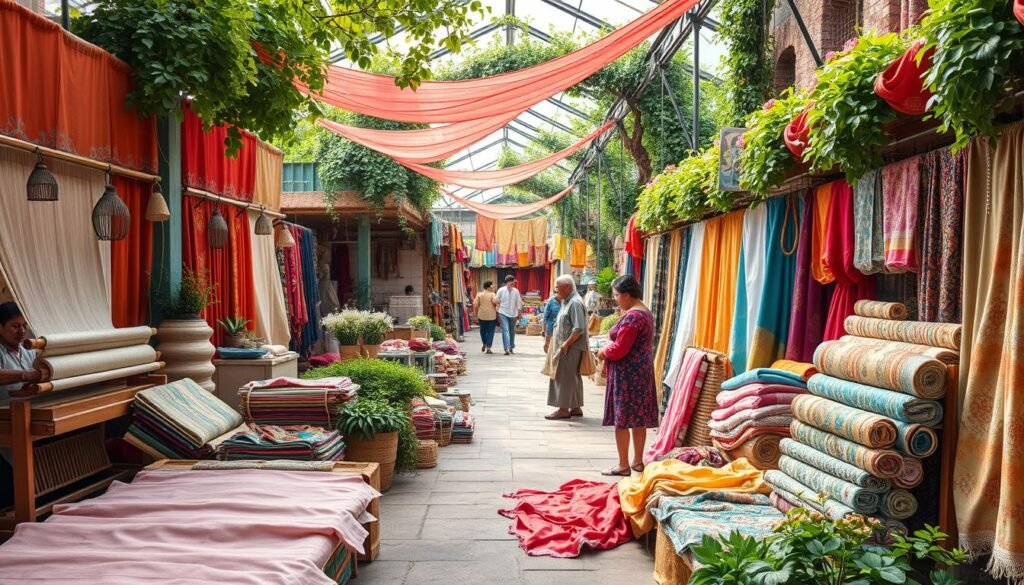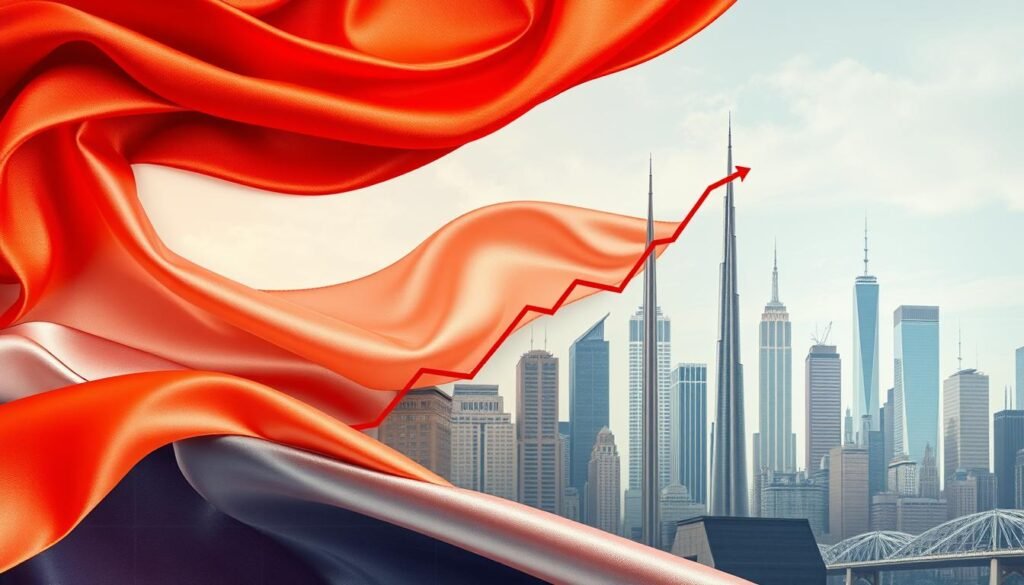“The future belongs to those who believe in the beauty of their dreams.” – Eleanor Roosevelt. This quote holds meaning in the silk fabric market. Here, dreams of luxury and sustainability come together.
As we explore this market, we see it’s more than just elegance. It’s changing with innovation and what people want.
The silk fabric market is a big part of textiles. It was worth about USD 17.2 billion in 2022. By 2030, it’s expected to reach USD 28.5 billion. This growth is driven by a love for luxury textiles and a move towards sustainable practices.
This article will look at what shapes the silk fabric market. We’ll see how recent events have affected it and the chances it has for growth. With countries like China and India leading, we’ll learn a lot about silk production.
Key Takeaways
- The global silk textiles market was valued at USD 124.2 billion in 2023.
- Projected CAGR of 8.0% from 2024 to 2030 indicates robust growth.
- The fashion segment is the largest contributor within the silk textiles market.
- Asia-Pacific holds the leading market share, driven by countries like China and India.
- Retail sales channels dominate the silk textile market in terms of distribution.
- Key players in the market are focusing on sustainable product innovations.
Introduction to the Silk Fabric Market
The silk fabric market has a rich history and tradition. It is also changing with new consumer tastes. People are now looking for silk that comes from ethical sources and is made in a way that’s good for the planet.
Mulberry silk is very popular because it’s high quality and strong. This type of silk is used in fashion, home décor, and healthcare. People care a lot about eco-friendly products today. So, companies are finding new ways to make silk better and more sustainable.
There have been some issues, like how traditional silk is made. But the silk market is bouncing back. Companies are looking at cruelty-free options and new technology. After COVID-19, people are again excited about silk. It keeps its special place in the luxury world.
Current Market Value of Silk Fabric
The silk textiles market is valued at about USD 17.2 billion in 2022. This shows the high demand for quality fabrics in the fashion world. Experts expect the value to grow to USD 20.0 billion by 2024, reaching USD 44.6 billion by 2034.
The silk industry is growing fast, with an 8.4% increase expected from 2024 to 2034. Countries like China and India lead in silk production. More people can buy luxury items now, boosting the silk market.
The silk sector saw a 9.6% growth rate from 2019 to 2023. Silk’s fine features and the world’s love for top-notch materials raise its market value.
Silk Fabric Market Growth Rate
The silk fabric market is growing fast. It’s expected to go up by 7.60% each year from 2024 to 2031. The demand for luxurious silk items is rising worldwide. The market’s value will jump from USD 20.91 billion in 2023 to USD 35.63 billion in 2031. This shows silk fabric is becoming more popular.
Projected CAGR for Silk Fabric Market
People want more high-quality, eco-friendly silk fabrics. This is helping the market grow. Asia-Pacific, especially China and India, play a big part in this. They are key places for making silk. Their skills in silk farming and weaving help the market grow.
Factors Influencing Growth Trends
Many things are making the silk market grow:
- Rising Global Population: More people means a bigger need for fancy fabrics for clothes and homes.
- Sustainability Awareness: People like things made in a way that’s good for the planet. Silk is perfect for this.
- Technological Innovations: Better ways of making silk are making it nicer and easier to get.
- High-End Market Demand: More people want luxury fabrics. This makes silk even more popular.
Silk fabrics are becoming more popular for many reasons. They are making a big mark in the textile world.
Driving Forces Behind Silk Fabric Demand
The demand for silk fabric is rising due to many factors. People now want sustainable fabrics more than ever. This is not just a passing trend. It’s a big change in how we see textiles. Now, more people can buy high-quality silk because they have more money.
Consumer Preference for Sustainable Fabrics
Nowadays, people are choosing sustainable fabrics that are good for the planet. They prefer to buy textiles made in a responsible way. Because of this, brands offer products from organic silk with eco-friendly methods. Silk is seen as a smart choice, connecting customers and the textile world closer.
Technological Advancements in Silk Production
New technology is changing how silk is made, making it better for the environment and more efficient. Innovations like better sericulture and eco-friendly dyeing are key. They make more silk available and cut costs. These improvements keep silk’s quality high and make it more versatile. This helps silk enter new markets, from clothing to home items.

| Driving Force | Description | Impact on Market |
|---|---|---|
| Consumer Demand for Sustainability | Increased interest in sustainable and eco-friendly fabrics. | Higher sales of organic silk products. |
| Technological Innovations | Advancements in silk production technology enhancing efficiency. | Reduced production costs and improved product quality. |
| Rising Disposable Income | Growth in consumer spending power. | Increased access to luxury silk items. |
| Expanded Applications | Wider use of silk in various industries. | New market opportunities in fashion and home textiles. |
Impact of COVID-19 on Silk Fabric Market
The COVID-19 pandemic changed the silk fabric market a lot. Luxury clothing saw less demand, pushing brands toward comfy silk loungewear. This shows a big shift in what customers want, caused by the pandemic’s challenges.
Changes in Consumer Behavior During the Pandemic
The pandemic led to a 30% decline in global silk revenue in 2020, making it $8.3 billion. About 70% of silk fabric makers had trouble getting materials. Yet, online silk sales went up by 40%.
- Spending on fancy silk goods fell by 25% as people changed what they buy.
- More people shopping online has become a new normal.
Recovery Trends in the Post-Pandemic Era
As things get better, the silk market might grow 15% by 2023. This growth shows how the market is adapting. There’s a move towards more sustainable silk production and a steady demand for comfy products.
Forecasts say the silk market might grow by CAGR of 4.93% from 2024 to 2031. To keep up with new customer needs, investing in new, eco-friendly ways to make silk is key.
Silk Fabric Market Size Segmentation
The silk fabric market shows many opportunities for division. This affects buyer choices and the whole market scene. Knowing these parts is crucial for companies. They want to focus on product types and reach the right buyers through suitable sales channels.
By Product Type: Apparel, Bedding, and Accessories
Apparel is a big player in the silk market. It takes up a large part of sales. Mulberry silk is top choice for fancy clothes. Bedding and accessories also add a lot to sales.
People now want luxury that’s also good for the planet. So, they’re getting more interested in silk things.
By Sales Channel: Retail vs. E-Commerce
Retail shops were once the go-to for buying silk. But now, things are changing. Online shopping is more popular, thanks to its ease and the push from recent global events.
Brands are updating how they market themselves. They’re focusing online to meet new buyer habits.
| Product Type | Market Share (%) |
|---|---|
| Apparel | 55 |
| Bedding | 30 |
| Accessories | 15 |
Now, we see a smart approach to market segmentation in silk. This helps companies do well. To learn how they aim to make clients happy with quality and service, see Tianruiyi’s dedication to new ideas and caring for our planet.
Regional Insights of the Silk Fabric Market
The silk fabric market shows a varied landscape. Different areas highlight distinct market performances. Asia-Pacific leads, thanks to China and India’s long history with silk.
Leading Regions: Asia-Pacific, North America, Europe
In Asia-Pacific, China and India are key to silk’s growth. North America’s market stands at about USD 3 billion in 2023. By 2030, it’s expected to hit USD 5.04 billion, growing at 7.7% yearly.
Europe is growing fast, too. Luxury fashion and eco-friendly products are big reasons why.
Market Share Distribution by Region
| Region | Market Value (2023) | Projected Value (2030) | CAGR (%) |
|---|---|---|---|
| Asia-Pacific | Leading Region | – | High |
| North America | USD 3 billion | USD 5.04 billion | 7.7% |
| Europe | Growing Market | – | Magnificent |
In North America, companies like Anhui Silk and Bolt Threads shape the market. The demand for silk textiles and its use in cosmetics are rising. These factors make the region strong in the silk market.
Looking at custom silk products? Personalized design is big. It shows silk’s ability to meet customer wants across regions.
Silk Fabric Market Size in the United States
The U.S. silk market shows great potential in North America. Consumers now prefer sustainable luxury silk that is also ethical. This trend helps the U.S. silk market grow along with the global love for natural fibers.
In 2023, the global silk market reached USD 124.2 billion. It could grow more from 2024 to 2030 by 8.0% each year. U.S. buyers want ethically made silk. This encourages U.S. production to meet these high standards.
Retail stores are still popular for buying silk. Yet, online shopping is growing, reaching more people. This helps the U.S. silk market grow even more.

Silk is loved in fashion and home decor. This makes the U.S. a key player. The U.S. silk market grows by meeting buyer needs with new ways to make silk.
Challenges Facing the Silk Fabric Market
The silk industry faces many market challenges. Prices for raw silk can go up and down a lot. This makes the market unstable. High costs come from needing a lot of work to make silk. These problems make it hard for companies to make money and grow.
Depending too much on places like Eastern China adds difficulties. This area is great for growing mulberry and raising silkworms. But, it can lead to not having enough resources everywhere. Problems with politics and trade policies can affect getting what’s needed for making silk.
Big companies are trying to keep their customers loyal and make good products. They focus on great craftsmanship, which makes things more expensive. Even so, they deal with tough price competition. This makes their financial problems even bigger.
Still, there’s hope for the silk industry. New ways to farm silk are helping lower costs and make more. People want more silk in clothes and beauty products. So, it’s important for businesses like Suzhou Tianruiyi Textile Co., Ltd to focus on quality and new ideas.
| Challenge | Description |
|---|---|
| Price Volatility | Fluctuations in raw silk prices create instability and affect profitability. |
| High Production Costs | Labor-intensive cultivation processes increase overall manufacturing expenses. |
| Geopolitical Dependence | Reliance on specific regions for raw materials leads to supply chain risks. |
| Price Competition | Intense competition forces companies to balance quality and affordability. |
| Resource Allocation | Unequal distribution of raw materials complicates production logistics. |
Competitive Landscape of the Silk Fabric Market
The silk fabric market is lively and full of changes. It was worth USD 10,922.02 million in 2021. Experts think it will grow to USD 16,387.16 million by 2027. Companies like Anhui Silk Co. Ltd. and Eastern Silk Industries are making smart moves. They want to get better spots in the market. Wujiang First Textile Co. is also joining in, using new strategies.
Key Players and Their Market Strategies
Top companies in the silk fabric market want to stand out more. They focus on high quality and being green to draw in customers. Customers now want products that are good for the earth. Making Mulberry Silk is one way they meet this demand. It’s used in clothes and beauty products. By doing this, companies stay ahead in the game despite costs and upkeep issues.
Mergers and Acquisitions in the Silk Industry
The silk industry is seeing more deals and partnerships. Companies aim to offer more and enter new areas. They’re joining forces to make silk in a green way. This shows they’re into growing by coming together. It helps them come up with new things and meet what people want. Being flexible and teaming up is key in staying important in the market. Want to know how to pick a silk maker? Learn about how to check quality and find good sources here.
Future Trends in the Silk Fabric Market
The silk fabric market is changing fast, with big innovation in textiles. New silk uses are coming up in industries, especially in eco-friendly fashion. Silk’s various applications show bright future trends in the textile world.
Innovation in Silk Textile Applications
New ways to make silk are here, improving how it’s made and used. Things like bioengineering make silk more versatile and eco-friendly. Such changes are key as we move towards greener methods.
Rising Demand for Organic Silk Products
More people want organic silk because it’s sustainable. This is due to a rise in ethical and eco-friendly shopping. Thus, there’s a big chance for organic silk makers in the market.
| Year | Projected Market Size (USD Million) | CAGR |
|---|---|---|
| 2024 | 22,917.3 | 6.8% |
| 2033 | 41,428.9 | 6.8% |
In summary, new innovation in textiles and more desire for organic silk mean big growth. These elements will shape the future, putting silk at the heart of textile changes.
Conclusion
The silk fabric market is growing fast. It is driven by people wanting luxury and eco-friendly options. By 2023, the market will be worth about USD 3,742.8 million. By 2030, it’s expected to hit USD 4,309.4 million. This shows a steady increase at a 2.0% rate each year from 2024 to 2030.
Many things are shaping this market. One big thing is new technology. Another is people caring more about health and staying well. The biggest silk makers are in the Asia-Pacific area. China and India make nearly all the world’s silk. This pushes the industry to keep getting better and greener.
There are many chances for companies and shoppers in the future. The industry’s effort to be more sustainable is creating strong growth. Silk is not just about luxury anymore. It’s also about being kind to the planet. This means a bright future where what people want and caring for the earth go hand in hand.
FAQ
What is the current value of the silk fabric market?
In 2022, the silk market was worth around USD 17.2 billion. It’s expected to hit USD 28.5 billion by 2030. This shows a big interest in fancy fabrics.
What factors are driving growth in the silk fabric market?
More people want eco-friendly fabrics, incomes are rising, and luxury items are more popular. These are the main growth drivers.
How has consumer behavior changed since the COVID-19 pandemic?
The pandemic cut the demand for formal clothes but more people wanted comfy wear.
Now, there’s more focus on online shopping and making things in a green way.
Which regions are leading in the silk fabric market?
Asia-Pacific, especially China and India, leads due to their long silk history. Growth is also seen in North America and Europe, thanks to luxury fashion.
What challenges does the silk fabric market face?
The market struggles with changing silk prices, high costs to make it, and depending on countries like China for silk, which impacts supply chains.
What innovations are shaping the future of the silk fabric market?
New eco-friendly dyeing methods and better silk farming are making silk more popular. Also, people want organic silk, because they care about the planet.
How does the silk fabric market segment by product type?
By product, clothing leads the market. Bedding and accessories come next.
What role does e-commerce play in the silk fabric market?
Online sales are becoming key, helped by the pandemic and the convenience of online shopping. Brands are boosting their online presence to reach these buyers.




